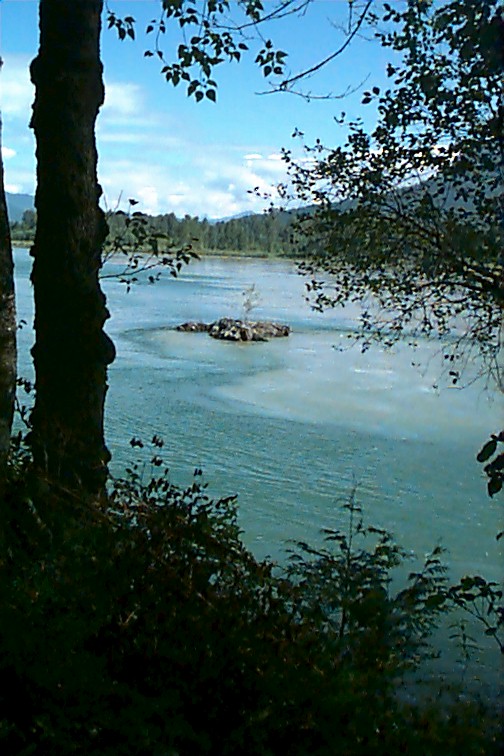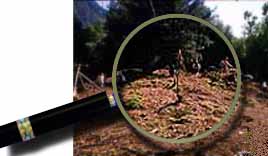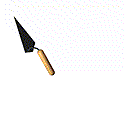'TWAS THE YEAR 1992 AT DhRl
16........
THE SITE
DhRl 16 is located on a point
of land that juts out where the
swirling water of two rivers
meet. These two rivers connect
the coast of British Columbia
with the Interior.
Because of this, they were
traveled often
by First Nations people who
used them for trading,
fishing and visiting neighboring
villages. The site would
have been very visible to anyone
coming down the river in a canoe.
DhRl 16 is a very old site.
Over a long period of time, many
people have lived there. That
is what makes it so interesting and
so confusing at the same time.
 In 1992, the First Nations
people who lived in this area, the Sto:lo,
asked R.G. Matson, an archaeologist
from the University
of British Columbia to come
and see this special area.
Since then, the First Nations
people and archaeologists have worked
together every year to try
and gain some insight and information
about the past there.
WHAT DO WE ALREADY KNOW?
Well, before any trowels ever
entered the ground, we
could already tell a bit about
the site by observing it (looking for clues!)
On the surface we could see
a lot of mounds of earth that
couldn't have been made by
natural processes. These mounds
were all different sizes, some
were huge, while others were quite small.
They were also spread
out all over the place. Most of them were
pretty close to the water,
where the two rivers met.
Because the two rivers meet
here, there is a lot of erosion,
the water slowly destroys the
bank by swirling past it so quickly.
Most importantly, the First
Nations people who live in the
area know that their ancestors
used to live there.
In 1992, the First Nations
people who lived in this area, the Sto:lo,
asked R.G. Matson, an archaeologist
from the University
of British Columbia to come
and see this special area.
Since then, the First Nations
people and archaeologists have worked
together every year to try
and gain some insight and information
about the past there.
WHAT DO WE ALREADY KNOW?
Well, before any trowels ever
entered the ground, we
could already tell a bit about
the site by observing it (looking for clues!)
On the surface we could see
a lot of mounds of earth that
couldn't have been made by
natural processes. These mounds
were all different sizes, some
were huge, while others were quite small.
They were also spread
out all over the place. Most of them were
pretty close to the water,
where the two rivers met.
Because the two rivers meet
here, there is a lot of erosion,
the water slowly destroys the
bank by swirling past it so quickly.
Most importantly, the First
Nations people who live in the
area know that their ancestors
used to live there.
 WHAT DO WE WANT TO KNOW?
The first things that the archaeologists
wanted to know was,
WHAT ARE THESE MOUNDS OF EARTH!?!?
Were people buried under the
mounds? Were they markers or
decorations? What were they?
Did people live at this site?
WHAT DID WE DO?
First off, we were ahead of
the game because we already had a big tip.
In the early 1900's, the archaeologist
Harlan Smith, the first archaeologist
to work in the Upper Fraser
Valley, discovered some
mounds and found out through
excavation that they were burial mounds.
So, we hypothesized that
that these mounds were also
used to mark burials.
If this was true, then we also thought that
the size differences could
be explained. People buried in large
mounds had higher status (they
had more honor and wealth)
than people buried in the smaller
mounds.
When you think about it, modern
cemeteries that you and I
see today are sometimes similar
to this.
Check out the activity to find
out more.
JUST
CLICK ON THE ARROW
WHAT DO WE WANT TO KNOW?
The first things that the archaeologists
wanted to know was,
WHAT ARE THESE MOUNDS OF EARTH!?!?
Were people buried under the
mounds? Were they markers or
decorations? What were they?
Did people live at this site?
WHAT DID WE DO?
First off, we were ahead of
the game because we already had a big tip.
In the early 1900's, the archaeologist
Harlan Smith, the first archaeologist
to work in the Upper Fraser
Valley, discovered some
mounds and found out through
excavation that they were burial mounds.
So, we hypothesized that
that these mounds were also
used to mark burials.
If this was true, then we also thought that
the size differences could
be explained. People buried in large
mounds had higher status (they
had more honor and wealth)
than people buried in the smaller
mounds.
When you think about it, modern
cemeteries that you and I
see today are sometimes similar
to this.
Check out the activity to find
out more.
JUST
CLICK ON THE ARROW  WHAT DID WE FIND?
Sure enough, our tip was a
good one.
We excavated two mounds, one
big and one medium in size.
Underneath the large
mound human remains (bones) were found.
One of the mounds had many
artifacts buried with it. These artifacts
were things that only a person
with status (someone who had money
or was well known or respected),
would have. So, we think that our
hypothesis was correct.
People buried in larger mounds had more status
than people buried in the smaller
mounds.
Archaeologists also noticed
that in some places there were
flat areas on the sufrace of
the ground in front of the mounds.
Archaeologists thought
they might be house depressions,
places where houses once stood.
So, we dug a small
exploratory trench (a little
pit) into the ground to
find out if we could see any
floors of what used to be houses. These
features are identifiable
by the hard-packed soil. Since there were
house floors observed in the
excavation, we wanted to find out
more about the houses at DhRl
16. So, with this knowledge
in hand...we waited patiently
until the next summer when field work
(excavation and research) could
begin again.
PSSSSTT! DO YOU WANNA CHECK
OUT SOME
TOP SECRET HINTS THAT WERE
USED IN 1992?
JUST CLICK ON THE EYEBALLS!
Pretty cool eh?
Can you guess what we did the
next year?
TAKE
ME THERE!!
WHAT DID WE FIND?
Sure enough, our tip was a
good one.
We excavated two mounds, one
big and one medium in size.
Underneath the large
mound human remains (bones) were found.
One of the mounds had many
artifacts buried with it. These artifacts
were things that only a person
with status (someone who had money
or was well known or respected),
would have. So, we think that our
hypothesis was correct.
People buried in larger mounds had more status
than people buried in the smaller
mounds.
Archaeologists also noticed
that in some places there were
flat areas on the sufrace of
the ground in front of the mounds.
Archaeologists thought
they might be house depressions,
places where houses once stood.
So, we dug a small
exploratory trench (a little
pit) into the ground to
find out if we could see any
floors of what used to be houses. These
features are identifiable
by the hard-packed soil. Since there were
house floors observed in the
excavation, we wanted to find out
more about the houses at DhRl
16. So, with this knowledge
in hand...we waited patiently
until the next summer when field work
(excavation and research) could
begin again.
PSSSSTT! DO YOU WANNA CHECK
OUT SOME
TOP SECRET HINTS THAT WERE
USED IN 1992?
JUST CLICK ON THE EYEBALLS!
Pretty cool eh?
Can you guess what we did the
next year?
TAKE
ME THERE!!





